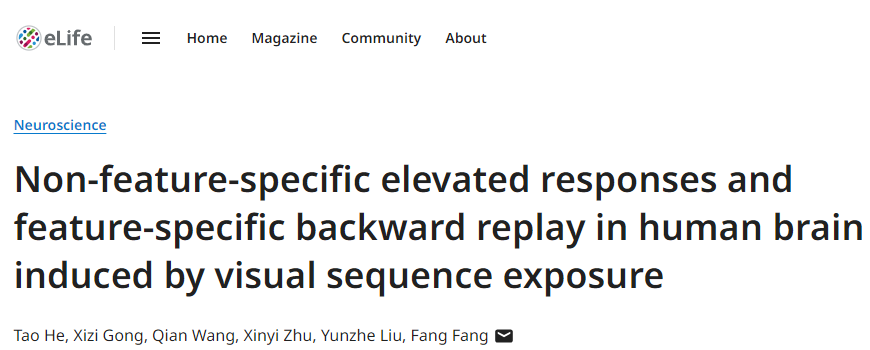elife | Prof. Fang Fang: Non-feature-specific elevated responses and feature-specific backward replay in human brain induced by visual sequence exposure
Abstract
The ability of cortical circuits to adapt in response to experience is a fundamental property of the brain. After exposure to a moving dot sequence, flashing a dot as cue at the starting point of the sequence can induce successive elevated responses even in the absence of the sequence. This cue-triggered elevated responses have been demonstrated to play a crucial role in predicting future events in dynamic environments. However, temporal sequences we are exposed usually contain rich feature information. It remains unknown whether the elevated responses are feature specific and, more crucially, how the brain organizes this sequence information after exposure. To address these questions, participants were exposed to a predefined sequence of four motion directions for about 30 min and subsequently presented with the start or end motion direction of the sequence as a cue. Surprisingly, we found that the cue-triggered elevated responses were not specific to a particular motion direction. Interestingly, the motion direction information was spontaneously reactivated and the motion sequence was backward replayed in a time-compressed manner. These effects were marginally significant even with brief exposure. Notably, no replay events were observed when the second or third motion direction of the sequence served as a cue. Further analyses revealed that activity in the medial temporal lobe (MTL) preceded the ripple power increase in visual cortex at replay onset, implying a coordinated relationship between the activities in the MTL and visual cortex. Together, we demonstrate that visual sequence exposure could induce two-fold brain plasticity that may simultaneously serve for different functional purposes. The non-feature-specific elevated responses may facilitate general processing of upcoming stimuli, whereas the feature-specific backward replay may underpin passive learning of visual sequence.
Original Link: https://elifesciences.org/reviewed-preprints/101511
